Intelligent, In-Vehicle Autonomous Decision-Making Functionality for Driving Style Reconfigurations
Abstract
1. Introduction
- It presents a novel in-vehicle decision-making functionality, able to proactively, efficiently, and securely decide on the most appropriate DS, in dynamically changing environments, considering all of the driver’s personal preferences, as well as contextual parameters from the vehicle’s environment.
- The proposed functionality acts in a fully autonomous (self-adaptive) manner, requiring no driver intervention.
- It follows a human-centric approach, where cognitive management techniques are incorporated to aggregate extensive data sources in real-time (driving surrounding context, driver’s preferences, and operational requirements) and interprets them to assess whether a specific DS is appropriate in each case.
2. Literature Review and Background Work
2.1. Research Areas and Achievements in ICVs
2.2. Bayesian Networks
3. Problem Description and Formulation
3.1. Problem Description
- Personalization: this requirement ensures that the proposed decisions are adapted to the driver’s needs;
- Adaptability: this requirement supports the efficient interaction with the users, with respect to their personality characteristics and personal preferences;
- Knowledge aggregation: this requirement aims to accelerate future decisions based on the information extracted from past interactions;
- Scalability: this allows the appropriate adaptation of the decisions, based on the particular contextual needs.
- Quality of service (QoS): these parameters are associated with the performance of the proposed ‘i-DSS’ functionality, such as comfort, economy, vehicle control, vehicle reaction, etc.;
- Profile and status of the driver: these parameters are associated with a specific driver of the ICV and their personality characteristics, such as driving experience, gender, age, gender, mental state, etc.;
- External driving environment: these parameters are associated with real-time crucial information obtained from infrastructure units or/and other ICVs, such as road type, vehicle congestion level, road condition, etc. Most of these data are impossible or difficult to measure directly from the in-vehicle sensors.
3.2. Business Case
4. Methodology
4.1. Proposed Framework and Parameters Selection
- two parameters associated with the driving environment scene; road condition (ROC) and road type (ROT);
- three QoS parameters; vehicle reaction (VER), comfort (COM), and economy (ECO)
4.2. Knowledge-Based Process
4.3. Selection Scheme
5. Results and Discussion
5.1. Simulation Setup and Assumptions
5.2. 1st Scenario: Normal/Regular Case
5.3. 2nd Scenario: Economy Case
5.4. 3rd Scenario: Impact of Road Condition
6. Conclusions and Future Directions
Author Contributions
Funding
Institutional Review Board Statement
Informed Consent Statement
Data Availability Statement
Conflicts of Interest
References
- Elliott, D.; Keen, W.; Miao, L. Recent Advances in Connected and Automated Vehicles. J. Traffic Transp. Eng. 2019, 6, 109–131. [Google Scholar] [CrossRef]
- Xu, W.; Sainct, R.; Gruyer, D.; Orfila, O. Safe Vehicle Trajectory Planning in an Autonomous Decision Support Framework for Emergency Situations. Appl. Sci. 2021, 11, 6373. [Google Scholar] [CrossRef]
- Fabiani, F.; Grammatico, S. Multi-Vehicle Automated Driving as a Generalized Mixed-Integer Potential Game. IEEE Trans. Intell. Transp. Syst. 2020, 21, 1064–1073. [Google Scholar] [CrossRef]
- Yeong, D.J.; Velasco-Hernandez, G.; Barry, J.; Walsh, J. Sensor and Sensor Fusion Technology in Autonomous Vehicles: A Review. Sensors 2021, 21, 2140. [Google Scholar] [CrossRef] [PubMed]
- Velez, G.; Otaegui, O. Embedding Vision-Based Advanced Driver Assistance Systems: A Survey. IET Intell. Transp. Syst. J. 2017, 11, 103–112. [Google Scholar] [CrossRef]
- Pendleton, S.; Andersen, H.; Du, X.; Shen, X.; Meghjani, M.; Eng, Y.; Rus, D.; Marcelo, H. Perception, Planning, Control, and Coordination for Autonomous Vehicles. Mach. J. 2017, 5, 6. [Google Scholar] [CrossRef]
- Li, L.; Wen, D.; Zheng, N.-N.; Shen, L.-C. Cognitive Cars: A New Frontier for ADAS Research. IEEE Trans. Intell. Transp. Syst. J. 2012, 13, 395–407. [Google Scholar] [CrossRef]
- Heide, A.; Henning, K. The ‘Cognitive Car’: A Roadmap for Research Issues in the Automotive Sector. Annu. Rev. Control 2006, 30, 197–203. [Google Scholar] [CrossRef]
- Dimitrakopoulos, G.; Bravos, G.; Nikolaidou, M.; Anagnostopoulos, D. A Proactive, Knowledge-Based Intelligent Transportation System Based on Vehicular Sensor Networks. IET Intell. Transp. Syst. J. 2013, 7, 454–463. [Google Scholar] [CrossRef]
- Felemban, E.; Sheikh, A. A Review on Mobile and Sensor Networks Iinnovations in Intelligent Transportation Systems. J. Transp. Technol. 2014, 4, 196–204. [Google Scholar]
- Chen, S.; Jian, Z.; Huang, Y.; Chen, Y.; Zhou, Z.; Zheng, N. Autonomous Driving: Cognitive Construction and Situation Understanding. Sci. China Inf. Sci. 2019, 62, 1–27. [Google Scholar] [CrossRef]
- Sumalee, A.; Ho, H.W. Smarter and More Connected: Future Intelligent Transportation System. IATSS Res. 2018, 42, 67–71. [Google Scholar] [CrossRef]
- Lv, C.; Hu, X.; Sangiovanni-Vincentelli, A.; Li, Y.; Martinez, C.M.; Cao, D. Driving-Style-Based Codesign Optimization of an Automated Electric Vehicle: A Cyber-Physical System Approach. IEEE Trans. Ind. Electron. 2019, 66, 2965–2975. [Google Scholar] [CrossRef]
- Desai, S.; Desai, S. Smart Vehicle Automation. Int. J. Comput. Sci. Mob. Comput. 2017, 6, 46–50. [Google Scholar]
- Kala, R.; Warwick, K. Intelligent Transportation System with Diverse Semi-Autonomous Vehicles. Int. J. Comput. Intell. Syst. 2015, 8, 886–899. [Google Scholar] [CrossRef]
- Russell, S.J.; Norvig, P. Artificial Intelligence: A Modern Approach; Prentice-Hall: Hoboken, NJ, USA, 2002. [Google Scholar]
- Neapolitan, R.E. Learning Bayesian Drivers; Prentice-Hall: Hoboken, NJ, USA, 2002. [Google Scholar]
- Mitchell, T.M. Machine Learning; The McGraw-Hill Companies, Inc.: New Youk, NY, USA, 1997. [Google Scholar]
- Liu, G.; Xu, Y.; He, Z.; Rao, Y.; Xia, J.; Fan, L. Deep Learning-Based Channel Prediction for Edge Computing Networks Toward Intelligent Connected Vehicles. IEEE Access 2019, 7, 114487–114495. [Google Scholar] [CrossRef]
- Fang, W.; Zhang, W.; Liu, Y.; Yang, W.; Gao, Z. BTDS: Bayesian-Based Trust Decision Scheme for Intelligent Connected Vehicles in VANETs. Trans. Emerg. Telecommun. Technol. 2020, 31, e3879. [Google Scholar] [CrossRef]
- Li, C.; Wang, S.; Li, X.; Zhao, F.; Yu, R. Distributed Perception and Model Inference with Intelligent Connected Vehicles in Smart Cities. Ad Hoc Netw. 2020, 103, 102152. [Google Scholar] [CrossRef]
- Xie, B.; Sun, Y.; Zhou, S.; Niu, Z.; Xu, Y.; Chen, J.; Gündüz, D. MOB-FL: Mobility-Aware Federated Learning for Intelligent Connected Vehicles. arXiv Prepr. 2022, arXiv:2212.03519. [Google Scholar]
- Meiring, G.; Myburgh, H. A Review of Intelligent Driving Style Analysis Systems and Related Artificial Intelligence Algorithms. Sensors 2015, 15, 30653–30682. [Google Scholar] [CrossRef]
- Sagberg, F.; Selpi, S.; Piccinini, G.F.B.; Engstrom, J. A Review of Research on Driving Styles and Road Safety. Hum. Factors E J. Hum. Factors Ergon. Soc. 2015, 57, 1248–1275. [Google Scholar] [CrossRef] [PubMed]
- Oliveira, L.; Proctor, K.; Burns, C.G.; Birrell, S. Driving Style: How Should an Automated Vehicle Behave? Information 2019, 10, 219. [Google Scholar] [CrossRef]
- Nastjuk, I.; Herrenkind, B.; Marrone, M.; Brendel, A.B.; Kolbe, L.M. What Drives the Acceptance of Autonomous Driving? An Investigation of Acceptance Factors from an End-User’s Perspective. Technol. Forecast. Soc. Chang. 2020, 161, 120319. [Google Scholar] [CrossRef]
- Hartwich, F.; Beggiato, M.; Krems, J.F. Driving Comfort, Enjoyment and Acceptance of Automated Driving–Effect of Driver’s Age and Driving Style Familiarity. Ergonomics 2018, 61, 1017–1032. [Google Scholar] [CrossRef]
- Panagiotopoulos, I.; Dimitrakopoulos, G. Cognitive Selection of Driving Automation Levels in Highly Automated Vehicles Leveraging on Bayesian Networking Principles. IET Intell. Transp. Syst. 2022, 16, 1127–1142. [Google Scholar] [CrossRef]
- Dimitrakopoulos, G.; Demestichas, P.; Koutra, V. Intelligent Management Functionality for Improving Transportation Efficiency by Means of the Car Pooling Concept. IEEE Trans. Intell. Transp. Syst. 2012, 7, 424–436. [Google Scholar] [CrossRef]
- Fagnant, D.J.; Kockelman, K. Preparing a Nation for Autonomous Vehicles: Opportunities, Barriers and Policy Recommendations. Transp. Res. Part A Policy Pract. 2015, 77, 167–181. [Google Scholar] [CrossRef]
- Ma, Z.; Zhang, Y. Drivers Trust, Acceptance, and Takeover Behaviors in Fully Automated Vehicles: Effects of Automated Driving Styles and Driver’s Driving Styles. Accid. Anal. Prev. 2021, 159, 106238. [Google Scholar] [CrossRef]
- Feng, Y.; Iravani, P.; Brace, C. A Fuzzy Logic-Based Approach for Humanized Driver Modelling. J. Adv. Transp. 2021, 2021, 1–13. [Google Scholar] [CrossRef]
- Chen, D.; Chen, Z.; Zhang, Z.; Qu, X.; Zhang, M.; Wu, C. Driving Style Recognition under Connected Circumstance Using a Supervised Hierarchical Bayesian Model. J. Adv. Transp. 2021, 2021, 1–12. [Google Scholar] [CrossRef]
- Sun, Z.; Li, J.; Tang, P.; Zhou, S.; Peng, X.; Li, X.N.; Wang, Q. Exploring Personalised Autonomous Vehicles to Influence User Trust. Cogn. Comput. 2020, 12, 1170–1186. [Google Scholar] [CrossRef]
- Hang, P.; Lv, C.; Xing, Y.; Huang, C.; Hu, Z. Human-Like Decision Making for Autonomous Driving: A Non-Cooperative Game Theoretic Approach. IEEE Trans. Intell. Transp. Syst. 2021, 22, 2076–2087. [Google Scholar] [CrossRef]
- Galante, F.; Mauriello, F.; Pernetti, M.; Rella Riccardi, M.; Montella, A. Effects of Traffic Control Devices on Rural Curve Lateral Position. Transp. Res. Rec. 2022, 2676, 162–180. [Google Scholar] [CrossRef]
- Eboli, L.; Mazzulla, G.; Pungill, G. How Drivers’ Characteristics Can Affect Driving Style. Transp. Res. Procedia 2017, 27, 945–952. [Google Scholar] [CrossRef]
- Brijs, T.; Mauriello, F.; Montella, A.; Galante, F.; Brijs, K.; Ross, V. Studying the Effects of an Advanced Driver-Assistance System to Improve Safety of Cyclists Overtaking. Accid. Anal. Prev. 2022, 174, 106763. [Google Scholar] [CrossRef]
- Sini, J.; Marceddu, A.C.; Violante, M. Automatic Emotion Recognition for the Calibration of Autonomous Driving Functions. Electronics 2020, 9, 518. [Google Scholar] [CrossRef]
- Khan, A. Cognitive Connected Vehicle Information System Design Requirement for Safety: Role of Bayesian Artificial Intelligence. J. Syst. Cybern. Inform. 2013, 11, 54–59. [Google Scholar]
- Wang, R.; Lukic, S.M. Review of Driving Conditions Prediction and Driving Style Recognition Based Control Algorithms for Hybrid Electric Vehicles. In Proceedings of the IEEE Vehicle Power and Propulsion Conference, Chicago, IL, USA, 6–9 September 2011. [Google Scholar] [CrossRef]
- SimEvents. Model and Simulate Message Communication and Discrete-Event Systems. Available online: https://www.mathworks.com/products/simevents.html (accessed on 1 January 2023).




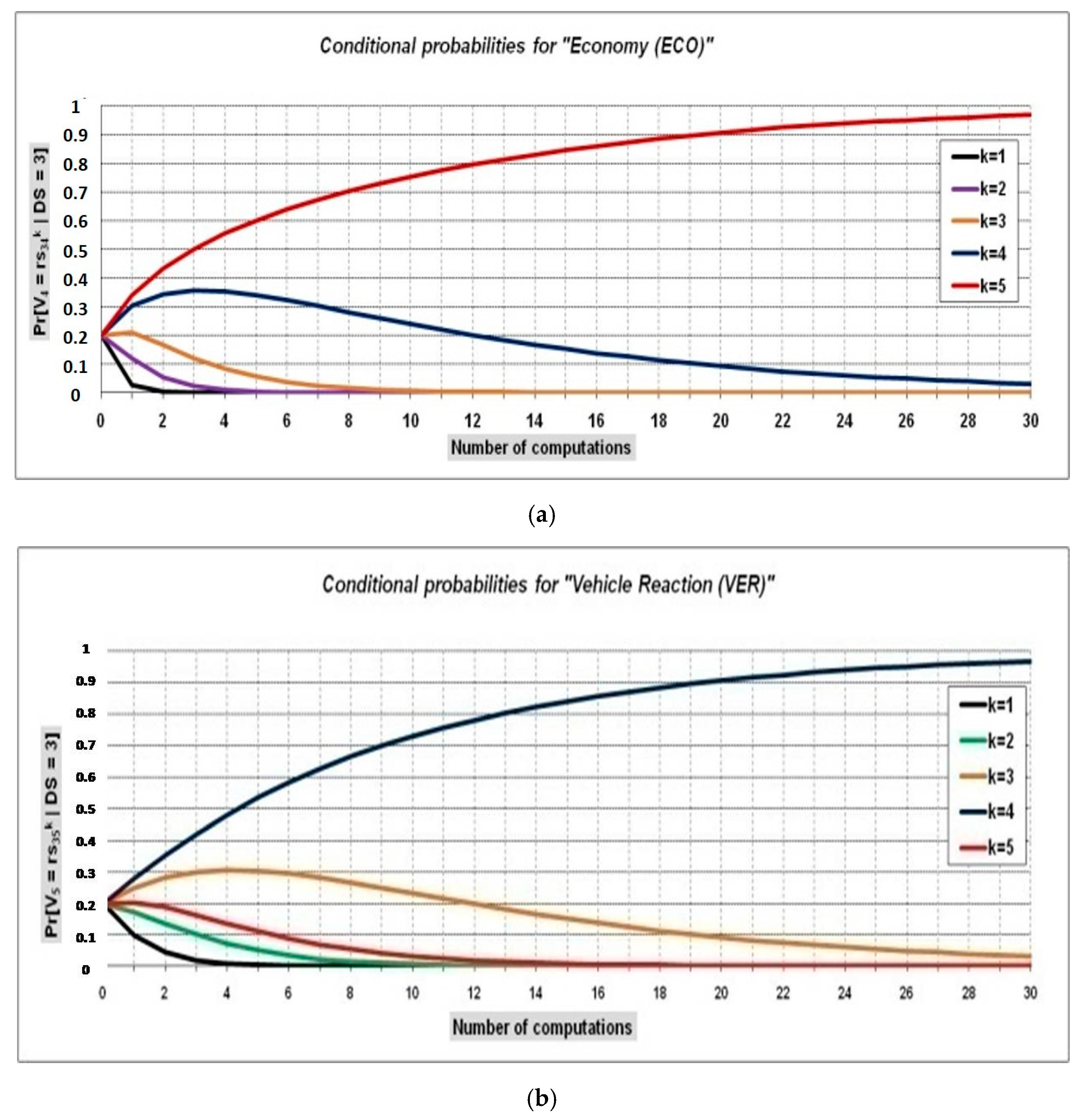
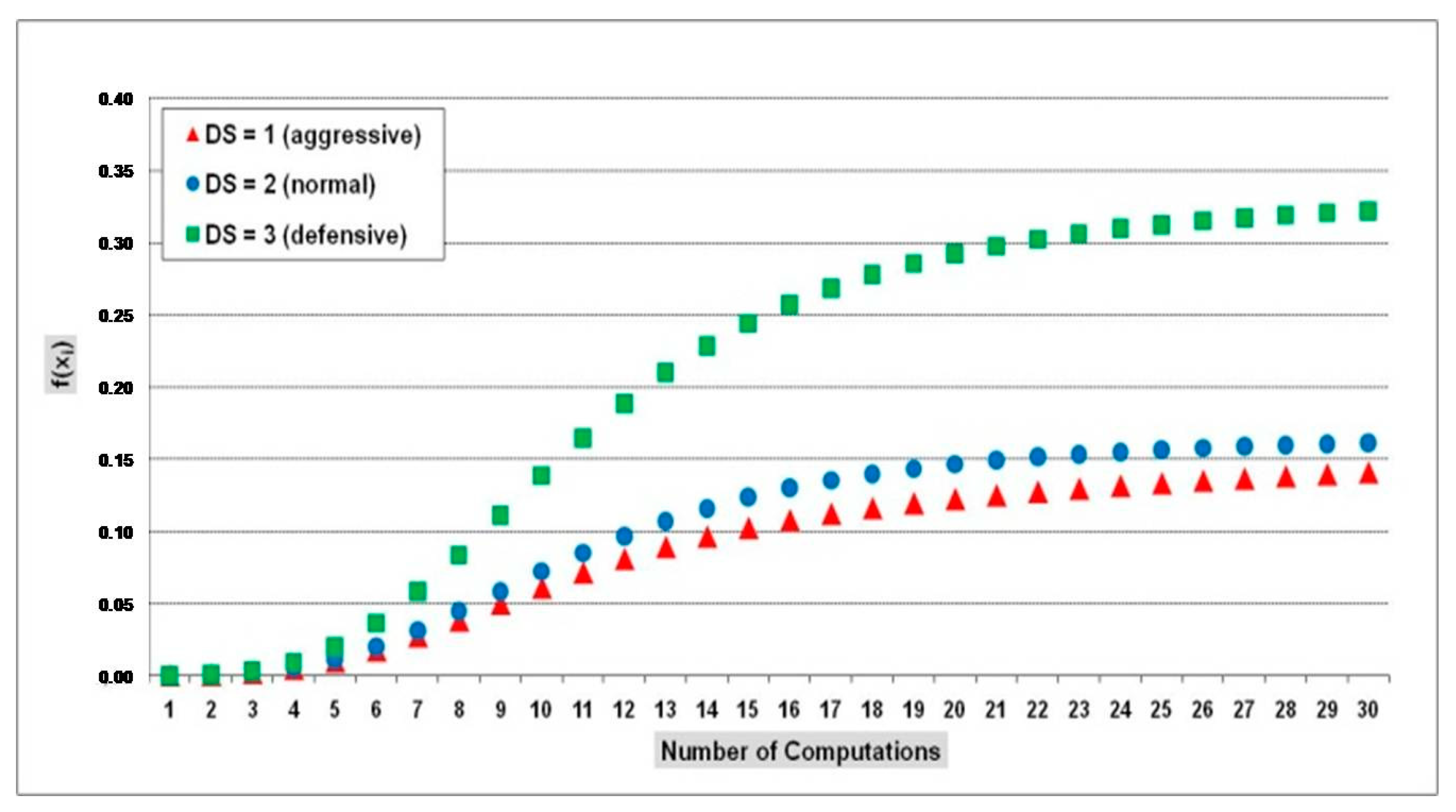


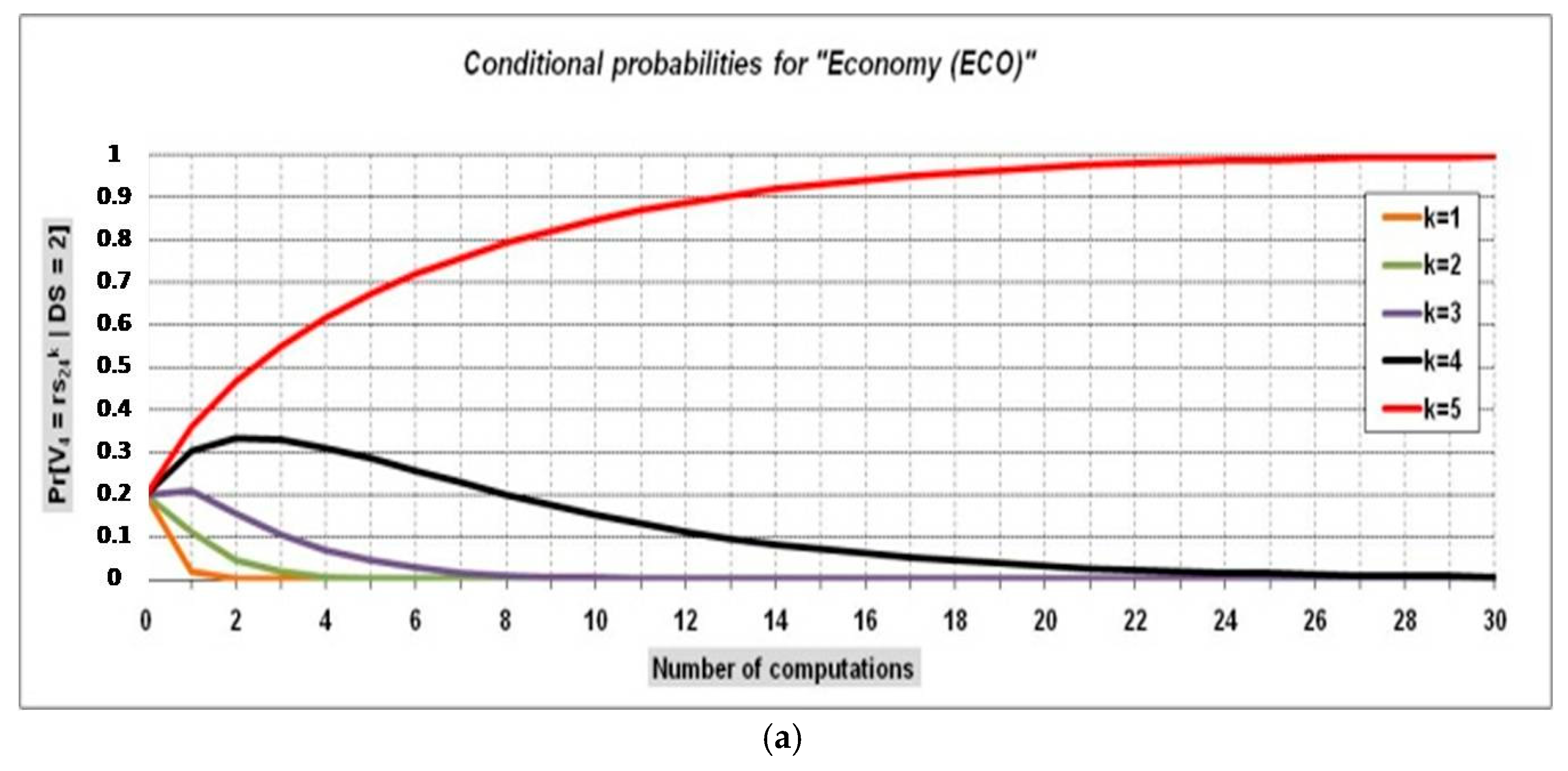
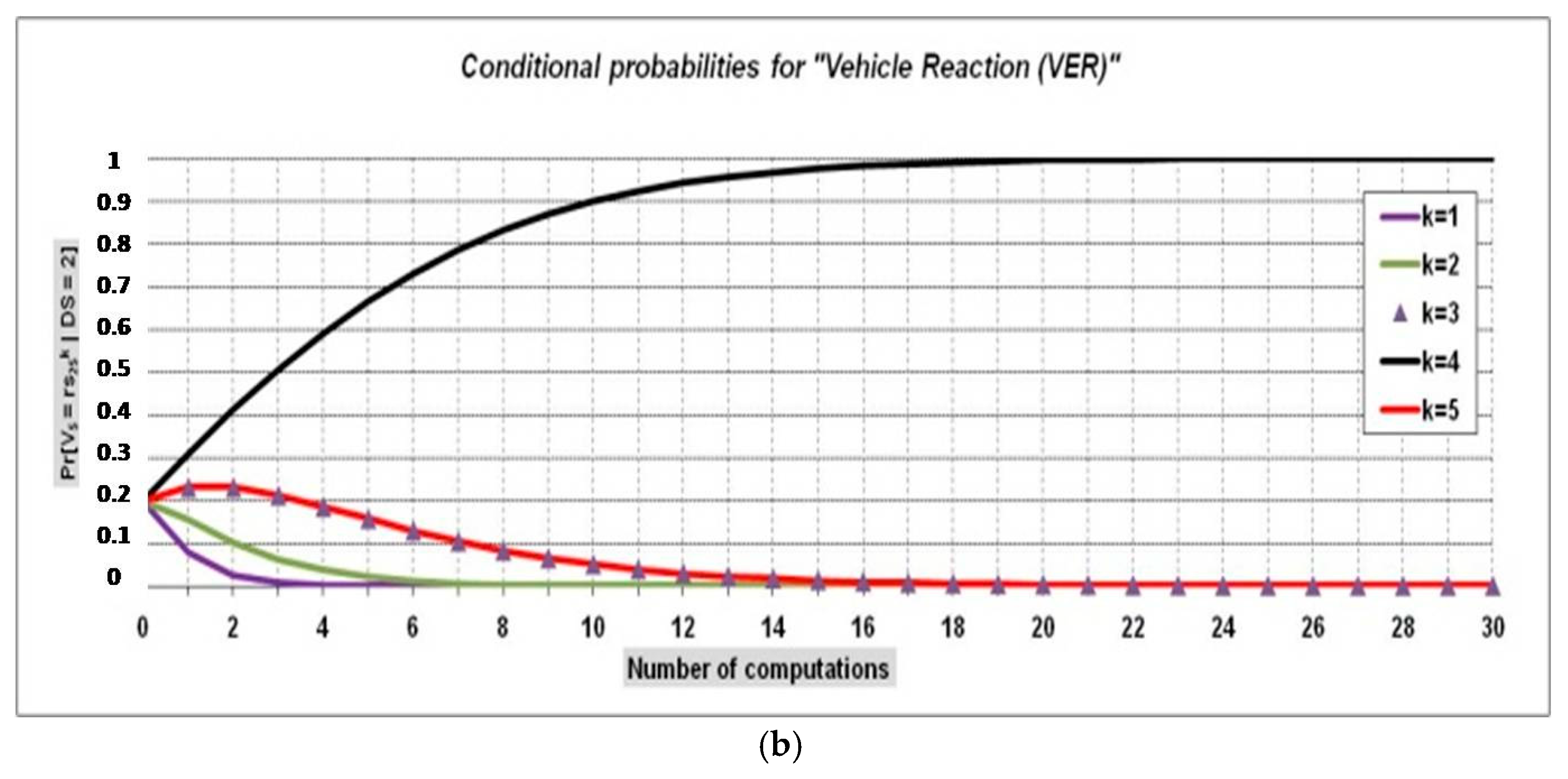

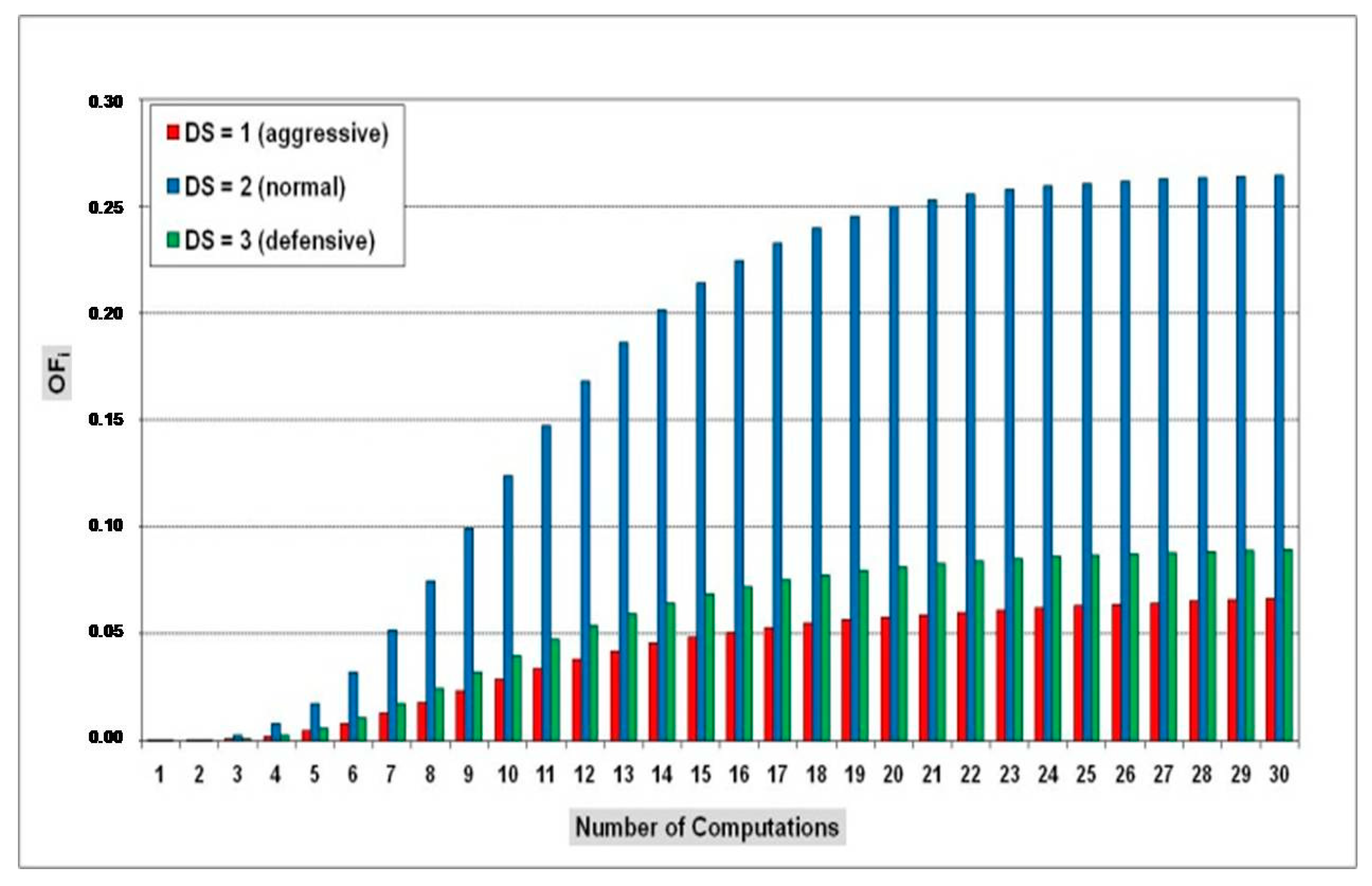



| #j | Contextual Parameter | Notation | Weight Value | Input Collected Value through the Evaluation Procedures | ||
|---|---|---|---|---|---|---|
| DS = 1 | DS = 2 | DS = 3 | ||||
| 1 | Road Type | ROT | 0.15 | 4 | 4 | 4 |
| 2 | Road Condition | ROC | 0.1 | 5 | 5 | 5 |
| 3 | Comfort | COM | 0.15 | 3 | 3.5 | 4 |
| 4 | Economy | ECO | 0.3 | 2.5 | 3 | 4.7 |
| 5 | Vehicle Reaction | VER | 0.3 | 3.4 | 3.7 | 4 |
| #j | Contextual Parameter | Notation | Weight Value | Input Collected Value through the Evaluation Procedures | ||
|---|---|---|---|---|---|---|
| DS = 1 | DS = 2 | DS = 3 | ||||
| 1 | Road Type | ROT | 0.05 | 5 | 5 | 5 |
| 2 | Road Condition | ROC | 0.25 | 3 | 3 | 3 |
| 3 | Comfort | COM | 0.1 | 3 | 4 | 3.5 |
| 4 | Economy | ECO | 0.5 | 2.5 | 4.8 | 3 |
| 5 | Vehicle Reaction | VER | 0.1 | 3.4 | 4 | 3.7 |
| #j | Parameter | Notation | Weight | Input Collected Value through the Evaluation Procedures | |||||
|---|---|---|---|---|---|---|---|---|---|
| DS = 1 | DS = 2 | DS = 3 | |||||||
| 1st | 2nd | 1st | 2nd | 1st | 2nd | ||||
| 1 | Road Type | ROT | 0.1 | 4 | 4 | 4 | 4 | 4 | 4 |
| 2 | Road Condition | ROC | 0.3 | 5 | 2 | 5 | 3 | 5 | 4 |
| 3 | Comfort | COM | 0.3 | 3 | 3 | 3 | 3 | 4 | 4 |
| 4 | Economy | ECO | 0.15 | 4.2 | 4.2 | 3.8 | 3.8 | 2.8 | 2.8 |
| 5 | Vehicle Reaction | VER | 0.15 | 4 | 4 | 3.7 | 3.7 | 3.4 | 3.4 |
Disclaimer/Publisher’s Note: The statements, opinions and data contained in all publications are solely those of the individual author(s) and contributor(s) and not of MDPI and/or the editor(s). MDPI and/or the editor(s) disclaim responsibility for any injury to people or property resulting from any ideas, methods, instructions or products referred to in the content. |
© 2023 by the authors. Licensee MDPI, Basel, Switzerland. This article is an open access article distributed under the terms and conditions of the Creative Commons Attribution (CC BY) license (https://creativecommons.org/licenses/by/4.0/).
Share and Cite
Panagiotopoulos, I.; Dimitrakopoulos, G. Intelligent, In-Vehicle Autonomous Decision-Making Functionality for Driving Style Reconfigurations. Electronics 2023, 12, 1370. https://doi.org/10.3390/electronics12061370
Panagiotopoulos I, Dimitrakopoulos G. Intelligent, In-Vehicle Autonomous Decision-Making Functionality for Driving Style Reconfigurations. Electronics. 2023; 12(6):1370. https://doi.org/10.3390/electronics12061370
Chicago/Turabian StylePanagiotopoulos, Ilias, and George Dimitrakopoulos. 2023. "Intelligent, In-Vehicle Autonomous Decision-Making Functionality for Driving Style Reconfigurations" Electronics 12, no. 6: 1370. https://doi.org/10.3390/electronics12061370
APA StylePanagiotopoulos, I., & Dimitrakopoulos, G. (2023). Intelligent, In-Vehicle Autonomous Decision-Making Functionality for Driving Style Reconfigurations. Electronics, 12(6), 1370. https://doi.org/10.3390/electronics12061370






